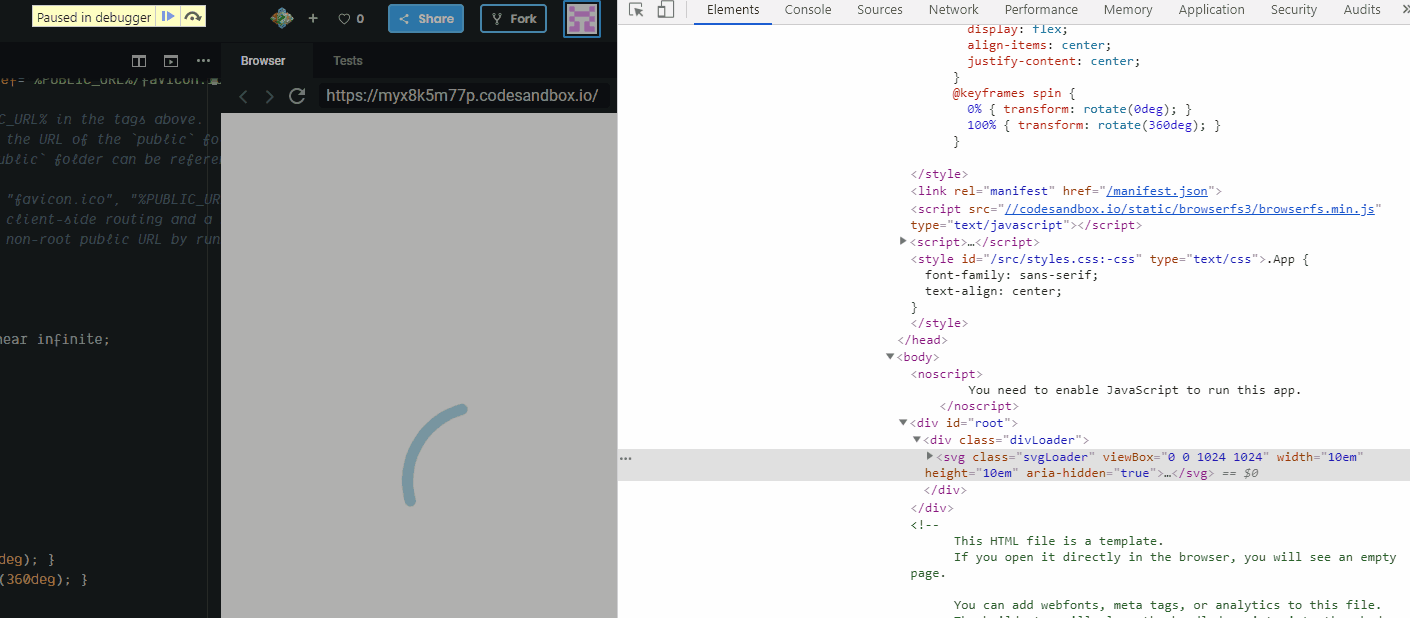This is an example from Google Adsense application page. The loading screen displayed before the main page showed after.

I don't know how to do the same thing with React because if I make loading screen rendered by React component, it doesn't display while page is loading because it has to wait for DOM rendered before.
Updated:
I made an example of my approach by putting screen loader in index.html and remove it in React componentDidMount() lifecycle method.
Example and react-loading-screen.
Just show a static loader before the UI is mounted But to just show something until mounted you just have to put something inside the div you will render the react tree into. Once react completes its render everything inside that element will be replaced.
If you're using a React class component you can use the shouldComponentUpdate method or a React. PureComponent class extension to prevent a component from re-rendering.
When the html page is rendered, display a spinner immediately (while React loads), and hide it after React is ready.
Since the spinner is rendered in pure HTML/CSS (outside of the React domain), React shouldn't control the showing/hiding process directly, and the implementation should be transparent to React.
Since you render react into a DOM container - <div id="app"></div>, you can add a spinner to that container, and when react will load and render, the spinner will disappear.
You can't add a DOM element (a div for example) inside the react root, since React will replace the contents of the container as soon as ReactDOM.render() is called. Even if you render null, the content would still be replaced by a comment - <!-- react-empty: 1 -->. This means that if you want to display the loader while the main component mounts, data is loading, but nothing is actually rendered, a loader markup placed inside the container (<div id="app"><div class="loader"></div></div> for example) would not work.
A workaround is to add the spinner class to the react container, and use the :empty pseudo class. The spinner will be visible, as long as nothing is rendered into the container (comments don't count). As soon as react renders something other than comment, the loader will disappear.
Example 1
In the example you can see a component that renders null until it's ready. The container is the loader as well - <div id="app" class="app"></div>, and the loader's class will only work if it's :empty (see comments in code):
class App extends React.Component {
state = {
loading: true
};
componentDidMount() {
// this simulates an async action, after which the component will render the content
demoAsyncCall().then(() => this.setState({ loading: false }));
}
render() {
const { loading } = this.state;
if(loading) { // if your component doesn't have to wait for an async action, remove this block
return null; // render null when app is not ready
}
return (
<div>I'm the app</div>
);
}
}
function demoAsyncCall() {
return new Promise((resolve) => setTimeout(() => resolve(), 2500));
}
ReactDOM.render(
<App />,
document.getElementById('app')
);.loader:empty {
position: absolute;
top: calc(50% - 4em);
left: calc(50% - 4em);
width: 6em;
height: 6em;
border: 1.1em solid rgba(0, 0, 0, 0.2);
border-left: 1.1em solid #000000;
border-radius: 50%;
animation: load8 1.1s infinite linear;
}
@keyframes load8 {
0% {
transform: rotate(0deg);
}
100% {
transform: rotate(360deg);
}
}<script src="https://cdnjs.cloudflare.com/ajax/libs/react/15.4.1/react.js"></script>
<script src="https://cdnjs.cloudflare.com/ajax/libs/react/15.4.1/react-dom.js"></script>
<div id="app" class="loader"></div> <!-- add class loader to container -->Example 2
A variation on using the :empty pseudo class to show/hide a selector, is setting the spinner as a sibling element to the app container, and showing it as long as the container is empty using the adjacent sibling combinator (+):
class App extends React.Component {
state = {
loading: true
};
componentDidMount() {
// this simulates an async action, after which the component will render the content
demoAsyncCall().then(() => this.setState({ loading: false }));
}
render() {
const { loading } = this.state;
if(loading) { // if your component doesn't have to wait for async data, remove this block
return null; // render null when app is not ready
}
return (
<div>I'm the app</div>
);
}
}
function demoAsyncCall() {
return new Promise((resolve) => setTimeout(() => resolve(), 2500));
}
ReactDOM.render(
<App />,
document.getElementById('app')
);#app:not(:empty) + .sk-cube-grid {
display: none;
}
.sk-cube-grid {
width: 40px;
height: 40px;
margin: 100px auto;
}
.sk-cube-grid .sk-cube {
width: 33%;
height: 33%;
background-color: #333;
float: left;
animation: sk-cubeGridScaleDelay 1.3s infinite ease-in-out;
}
.sk-cube-grid .sk-cube1 {
animation-delay: 0.2s;
}
.sk-cube-grid .sk-cube2 {
animation-delay: 0.3s;
}
.sk-cube-grid .sk-cube3 {
animation-delay: 0.4s;
}
.sk-cube-grid .sk-cube4 {
animation-delay: 0.1s;
}
.sk-cube-grid .sk-cube5 {
animation-delay: 0.2s;
}
.sk-cube-grid .sk-cube6 {
animation-delay: 0.3s;
}
.sk-cube-grid .sk-cube7 {
animation-delay: 0s;
}
.sk-cube-grid .sk-cube8 {
animation-delay: 0.1s;
}
.sk-cube-grid .sk-cube9 {
animation-delay: 0.2s;
}
@keyframes sk-cubeGridScaleDelay {
0%,
70%,
100% {
transform: scale3D(1, 1, 1);
}
35% {
transform: scale3D(0, 0, 1);
}
}<script src="https://cdnjs.cloudflare.com/ajax/libs/react/15.4.1/react.js"></script>
<script src="https://cdnjs.cloudflare.com/ajax/libs/react/15.4.1/react-dom.js"></script>
<div id="app"></div>
<!-- add class loader to container -->
<div class="sk-cube-grid">
<div class="sk-cube sk-cube1"></div>
<div class="sk-cube sk-cube2"></div>
<div class="sk-cube sk-cube3"></div>
<div class="sk-cube sk-cube4"></div>
<div class="sk-cube sk-cube5"></div>
<div class="sk-cube sk-cube6"></div>
<div class="sk-cube sk-cube7"></div>
<div class="sk-cube sk-cube8"></div>
<div class="sk-cube sk-cube9"></div>
</div>To have a more fine grained control over the spinners display state, create two functions showSpinner and hideSpinner, and pass them to the root container via props. The functions can manipulate the DOM, or do whatever needed to control the spinner. In this way, React is not aware of the "outside world", nor needs to control the DOM directly. You can easily replace the functions for testing, or if you need to change the logic, and you can pass them to other components in the React tree.
Example 1
const loader = document.querySelector('.loader');
// if you want to show the loader when React loads data again
const showLoader = () => loader.classList.remove('loader--hide');
const hideLoader = () => loader.classList.add('loader--hide');
class App extends React.Component {
componentDidMount() {
this.props.hideLoader();
}
render() {
return (
<div>I'm the app</div>
);
}
}
// the setTimeout simulates the time it takes react to load, and is not part of the solution
setTimeout(() =>
// the show/hide functions are passed as props
ReactDOM.render(
<App
hideLoader={hideLoader}
showLoader={showLoader}
/>,
document.getElementById('app')
)
, 1000);.loader {
position: absolute;
top: calc(50% - 4em);
left: calc(50% - 4em);
width: 6em;
height: 6em;
border: 1.1em solid rgba(0, 0, 0, 0.2);
border-left: 1.1em solid #000000;
border-radius: 50%;
animation: load8 1.1s infinite linear;
transition: opacity 0.3s;
}
.loader--hide {
opacity: 0;
}
@keyframes load8 {
0% {
transform: rotate(0deg);
}
100% {
transform: rotate(360deg);
}
}<script src="https://cdnjs.cloudflare.com/ajax/libs/react/15.4.1/react.js"></script>
<script src="https://cdnjs.cloudflare.com/ajax/libs/react/15.4.1/react-dom.js"></script>
<div id="app"></div>
<div class="loader"></div>Example 2 - hooks
This example uses the useEffect hook to hide the spinner after the component mounts.
const { useEffect } = React;
const loader = document.querySelector('.loader');
// if you want to show the loader when React loads data again
const showLoader = () => loader.classList.remove('loader--hide');
const hideLoader = () => loader.classList.add('loader--hide');
const App = ({ hideLoader }) => {
useEffect(hideLoader, []);
return (
<div>I'm the app</div>
);
}
// the setTimeout simulates the time it takes react to load, and is not part of the solution
setTimeout(() =>
// the show/hide functions are passed as props
ReactDOM.render(
<App
hideLoader={hideLoader}
showLoader={showLoader}
/>,
document.getElementById('app')
)
, 1000);.loader {
position: absolute;
top: calc(50% - 4em);
left: calc(50% - 4em);
width: 6em;
height: 6em;
border: 1.1em solid rgba(0, 0, 0, 0.2);
border-left: 1.1em solid #000000;
border-radius: 50%;
animation: load8 1.1s infinite linear;
transition: opacity 0.3s;
}
.loader--hide {
opacity: 0;
}
@keyframes load8 {
0% {
transform: rotate(0deg);
}
100% {
transform: rotate(360deg);
}
}<script crossorigin src="https://unpkg.com/react@16/umd/react.development.js"></script>
<script crossorigin src="https://unpkg.com/react-dom@16/umd/react-dom.development.js"></script>
<div id="app"></div>
<div class="loader"></div>This could be done by placing the loading icon in your html file (index.html for example), so that users see the icon immediately after the html file has been loaded.
When your app finishes loading, you could simply remove that loading icon in a lifecycle hook, I usually do that in componentDidMount.
The workaround for this is doing in your render function something like this:
constructor() {
this.state = { isLoading: true }
}
componentDidMount() {
this.setState({isLoading: false})
}
render() {
return(
this.state.isLoading ? *showLoadingScreen* : *yourPage()*
)
}
Initialize isLoading as true in the constructor and false on componentDidMount.
This will happen before ReactDOM.render() takes control of the root <div>. I.e. your App will not have been mounted up to that point.
So you can add your loader in your index.html file inside the root <div>. And that will be visible on the screen until React takes over.
You can use whatever loader element works best for you (svg with animation for example).
You don't need to remove it on any lifecycle method. React will replace any children of its root <div> with your rendered <App/>, as we can see in the GIF below.
Example on CodeSandbox

index.html
<head>
<style>
.svgLoader {
animation: spin 0.5s linear infinite;
margin: auto;
}
.divLoader {
width: 100vw;
height: 100vh;
display: flex;
align-items: center;
justify-content: center;
}
@keyframes spin {
0% { transform: rotate(0deg); }
100% { transform: rotate(360deg); }
}
</style>
</head>
<body>
<div id="root">
<div class="divLoader">
<svg class="svgLoader" viewBox="0 0 1024 1024" width="10em" height="10em">
<path fill="lightblue"
d="PATH FOR THE LOADER ICON"
/>
</svg>
</div>
</div>
</body>
index.js
Using debugger to inspect the page before ReactDOM.render() runs.
import React from "react";
import ReactDOM from "react-dom";
import "./styles.css";
function App() {
return (
<div className="App">
<h1>Hello CodeSandbox</h1>
<h2>Start editing to see some magic happen!</h2>
</div>
);
}
debugger; // TO INSPECT THE PAGE BEFORE 1ST RENDER
const rootElement = document.getElementById("root");
ReactDOM.render(<App />, rootElement);
If you love us? You can donate to us via Paypal or buy me a coffee so we can maintain and grow! Thank you!
Donate Us With